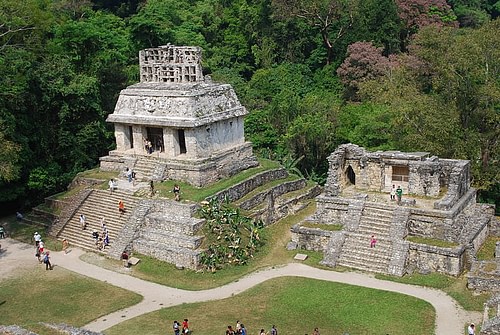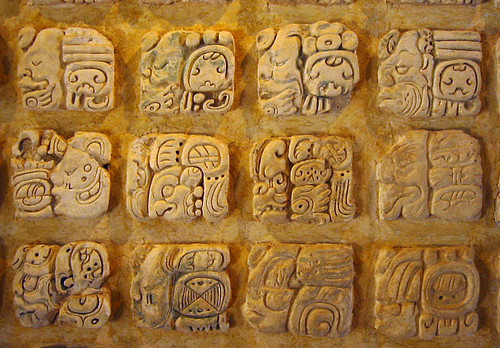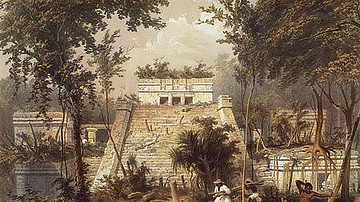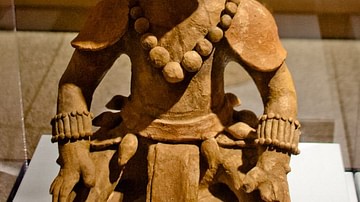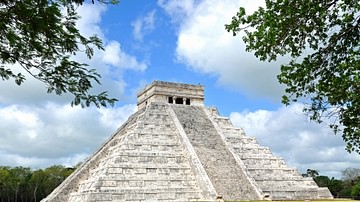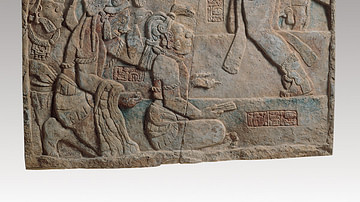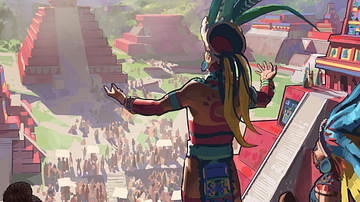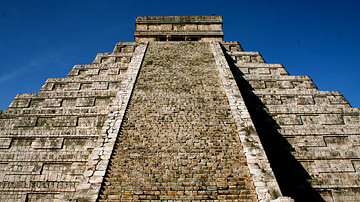Although John Lloyd Stephens and Frederick Catherwood are consistently credited with the `discovery' of the Maya Civilization, there were many who preceded them who sparked their interest in making their famous travels through Mesoamerica. The first non-Maya to explore the sites were Catholic priests who, many years after the Spanish Conquest of the region in the 16th century, visited the empty cities and told others about them. In 1695 the Friar Andres de Avendano y Loyola wrote extensively about the Maya and his missionary efforts in converting them to Christianity. In doing so, he gave early accounts of their culture, book making, religious beliefs and daily life. He also makes mention of certain sites, though not by recognizable names, which suggests that not every city was abandoned c. 950 CE but that some were re-inhabited. Even so, Avendano's accounts are biased in that he saw the Maya as deceptive heathens in need of salvation (Houston,et.al., 42). In 1773 the Father Ramon Ordonez de Aguilar wrote of the Maya of Palenque but so conflated stories he had heard with other accounts given by the Bishop Nunez de la Vega that his work is more mythology than fact. It is from Aguilar's efforts that the modern day belief in a non-existent Mayan god named `Votan' spring but, more significantly, the idea that the builders of the great cities of Mesoamerica came from the Middle East. According to Aguilar, Votan was the founder of Palenque and a great hero who traveled regularly to unspecified lands in the `old world' around Egypt and Palestine. Other works, or fragments of works, by priests and missionaries who had contact with the Maya display the same sort of fanciful interpretation of the people and their abandoned cities.
Aguilar's treatise motivated the Lieutenant Esteban Gutierrez to mount an expedition to Palenque in 1773 which inspired others to then do the same. These expeditions interested the Administrator Jose de Estacheria who sent Lieutenant Jose Antonio Calderon to Palenque in 1784. After receiving his report, Estacheria dispatched the Italian architect Bernasconi, under the auspices of the Spanish government, to the site. Bernasconi arrived in Palenque in 1785 to document and report on the city. In response to his report, the King of Spain sent Antonio del Rio to excavate Palenque in 1787 in the company of the artist Ricardo Armendariz and this is considered the first methodologically sound expedition to a Mayan site (Drew, 37-45). Armendariz's drawing of the ruins were the first glimpse the world had of the Maya Civilization.
Following del Rio's report, interest in the region grew and a number of other expeditions to `New Spain' were launched; among them that of Dupaix and Castaneda who were the first to produce a work of text accompanied by illustrations of a Mayan site (Palenque). Their work was not published in full until 1834 (in the folio Antiquities Mexicaines) but parts of it were released in 1822 which engaged the interest of many and, among them, the polymath Constantine Samuel Rafinesque who was then teaching and doing field work in Kentucky. Rafinesque's writings on language and the emerging world of the Maya would become an important inspiration for later explorers in deciphering the glyphs of the Maya and conducting a serious study of their culture (Danien, Sharer, 12). Following Dupaix and Castaneda, among others, was Juan Galindo, among whose contributions was confirming that the glyphs found at Palenque and those at Copan were the same writing system and a wholly different one from any of the known ancient or European languages.
As word of the ruins of places like Palenque and Copan grew, no one was willing to entertain the possibility that the natives of the region were the descendents of the architects and builders of the great cities and immense stela. The early suggestion by Aguilar that Palenque was founded by someone from the Middle East gave rise to persistent theories that the people who built the mysterious cities of Mesoamerica were the lost tribes of Israel or Egyptians or survivors from the lost continent of Atlantis or Chinese refugees fleeing Kubla Khan. Explorers after Galindo did little to dispel this erroneous belief and, especially, Edward King the Viscount Kingsborough, Charles Etienne Basseur de Bourbourg, a French writer, and Jean -Frederic Maximilien, Comte de Waldek, whose illustrations of Mayan sites accompanied Bourbourg's text.
Edward King, Viscount Kingsborough believed that the Maya were the lost tribes of Israel to such an extent that he had the artist Augustino Aglio illustrate the 1830 work Antiquities of Mexico in such a way as to prove his hypothesis. According to Stuart, he also had the artist "search out, copy, and later color any `Mexican' manuscripts that could be found in the libraries of Europe" (Danien, Sharer, 11). His two volume set amounted to a massive tome of propaganda for his personal belief regarding the Maya and propagated the understanding that the cities of Mesoamerica were created by those classical civilizations already known and admired by Europe. His vision was expanded upon dramatically by Charles Etienne Basseur de Bourbourg in a way Kingsborough could not have imagined.
Bourbourg was ordained a priest in 1845 and sent on missionary work to Central America. From his youth he had shown a very active imagination and his early published material was criticized as largely plagiarism and conflation of other people's work (most notably Chateaubriand's). This tendency to ignore the facts and embellish upon other's work characterizes all of Bourbourg's writing. Taking a cue from Kingsborough, Bourbourg also maintained that the cities of the Maya could not have been constructed by the ancestors of the people living in the region. Looking for support for his theory, he inadvertently provided future Mayanists with much valuable information and helped bring the Maya to the attention of the world at large. He translated the Popol Vuh into French in 1861 and an abridged version of Diego de Landa's seminal work in 1862 (Catholic Encyclopedia). Holding fast to a belief that the lost continent of Atlantis was historical truth, and not just Plato's fable, he interpreted the ruins of the Maya as positive proof that the builders of the cities were Atlanteans. His writings after 1862 concern themselves with trying to show how closely the Mayan architecture (and civilization as inferred from the empty cities) mirrored that of Plato's description of Atlantis. In 1866 he published his Monuments Ancien du Mexique with accompanying illustrations by Count Waldek.
Waldek was an explorer and adventurer whose life is difficult to separate from the myths he himself spun around it. He had allegedly traveled the world before the age of twenty, served with Napoleon, studied under Jacques Louis-David, and was friends with Lord Byron and Marie Antoinette (Drew, 48). He was convinced that the Mayan cities were in some way linked to the Middle East and, most likely, to the Egyptians. He lived in the ruins of Palenque in 1832 and claimed to have stayed there for three years (though some sources claim it was only three months) with an exotic Maya mistress. His drawings of the various sites he visited, though fine pieces of artwork, were not accurate and rendered the ruins in a highly romantic style which was influenced by his belief that ancient Egyptians had constructed the cities he depicted. One of his drawings clearly shows a Mayan figure with a headdress adorned by an elephant in an effort to link the builders of the cities with the known civilizations of the ancient world, in this case, India (Drew, 50). Waldek had allegedly visited the Yucatan in 1819 and it is thought that the stories of his adventures may have sparked or encouraged Rafinesque's interest in the Maya. However the two men met, Waldek wrote letters to Rafinesque during his time in Mesoamerica on the importance of deciphering the Mayan glyphs; an urgency which Rafinesque impressed upon John Lloyd Stephens (Stuart in Danien, Sharer, 13-16). Waldek's influence over the interpretation of the origin of the Mayan ruins was considerable as he was a very accomplished artist and this concept of a euro-centric origin for the `mysterious' cities continued.
John Lloyd Stephens was the first of those who undertook a study of the Mayan culture to assert firmly that the ruins found across Mesoamerica were produced by the indigenous population. Stuart writes, "Unlike his predecessors, John Lloyd Stephens correctly believed that the Maya themselves were responsible for the cities he had seen, and speculated with instinctive logic that the hieroglyphs carved on the stones dealt with the history of their kings" (Stuart & Stuart, 30). In 1839, accompanied by the accomplished artist and architect Frederick Catherwood, Stephens would embark on his first journey to Mesoamerica and, in doing so, would bring the Maya civilization to the attention of the world. The popularity of his books, complemented by Catherwood's lithographs, completely changed the understanding of the Maya and lay the foundation for future scholarly study not only of the Maya civilization, but of all Mesoamerican cultures.
